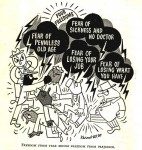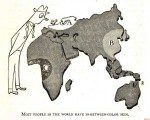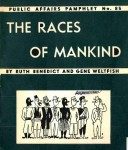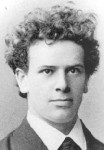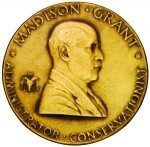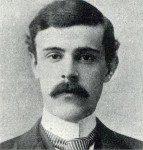More on Ruth Benedict and Gene Weltfish’s The Races of Mankind:
After World War I the Germans and the Czechs along the border between the two countries intermarried so often that the Germans of this section got to look like Czechs and the Czechs began to speak German. But this did not make the two countries love each other.
People of every European nation have racial brothers in other countries, often ones with which they are at war. If at any one moment you could sort into one camp all the people in the world who were most Mediterranean, no mystic sense of brotherhood would unite them. Neither camp would have language or nationality or mode of life to unite them.
The same applies to mankind as a whole – yet anti-“racists” argue in favor of a mystic sense of brotherhood uniting all of mankind.
Pretending race doesn’t exist doesn’t make race go away.
The movements of peoples over the face of the earth inevitably produce race mixture and have produced it since before history began. No one has been able to show that this is necessarily bad.
They know race mixing is not inevitable, which is why they take the trouble to argue and propagandize in favor of it. They wish to thwart the natural human tendency to discriminate and separate.
But, as far as we know, there are no immutable laws of nature that make racial intermixture harmful.
Harmful for who?
No immutable laws of nature make extinction harmful. Group identity, self-awareness, morality – group judgment of good and bad – is what gives words like “harmful” meaning.
The thesis of Arthur Gobineau’s The Inequality of Human Races is that each society throughout history has been an expression of a racial/national core, and that their success leads to conquest, then mixing, then collapse.
Racial Superiorities and Inferiorities
to prove superiority … you have to test abilities
Science therefore treats human racial differences as facts to be studied and mapped. It treats racial superiorities as a separate field of investigation; it looks for evidence. When a Nazi says “I am a blue-eyed Aryan and you are non-Aryan,” he means “I am superior and you are infenor.” The scientist says: “Of course. You are a fair-haired, long-headed, tall North European (the Anthropological term is Nordics, not Aryans), and I am a dark-haired, round-headed, less tall South European. But on what evidence do you base your claim to be superior? That is quite different.”
Race prejudice turns on this point of inferiority and superiority. The man with race prejudice says of a man of another race, “No matter who he is, I don’t have to compare myself with him. I’m superior anyway. I was born that way.”
Anti-“racism” turns on this point of inferiority and superiority, playing on insecurity, fear of exclusion. A “racist” who says “born different” is saying superior/inferior is beside the point, though having a sense of pride in one’s own group is perfectly normal and natural.
Pages 16 and 17 of the pamplet are missing. This portion of the pamphlet discusses IQ. The tail end of it is on page 18 (italics in original):
The white race did badly where economic conditions were bad and schooling was not provided, and Negroes living under better conditions surpassed them. The differences did not arise because people were from the North or the South, or because they were white or black, but because of differences in income, education, cultural -advantages, and other opportunities.
From the page on Gene Weltfish at Wikipedia:
The most controversial statement was the mention of a set of IQ tests administered to the American Expeditionary Force (AEF) in World War I, in which “Southern Whites” scored below “Northern Negroes”. Weltfish and Benedict argued that “The difference….[arose] because of differences of income, education, cultural advantages, and other opportunities,” since southern schools spent only a fraction of the amount spent on education in the North. This was the statement that led to a general outcry in the military. The bulk of the pamphlet was dedicated to explaining that perceived differences in group mental abilities vary in accordance with social and cultural factors, not biological ones.
The heritability of IQ and racial differences in IQ are well established. The controversy over this comes entirely from anti-“racists” who simply want to deny and suppress these facts. See, for example, The Bell Curve and the “debate” it spawned.
A large portion of the anti-“racist” fraud, from 1943 through to this day, having to do with IQ and other racial differences, is conflating overlap with equality. It is a kind of hand-waving – a deliberate attempt to induce confusion and minimize differences in norms and averages by pointing to overall variance. A specific example has come to be known as the Lewontin fallacy, which I’ll discuss in more detail in a future installment.
Character Not Inborn
The second superiority which a man claims when he says, “I was born a member of a superior race/’ is that his race has better character. The Nazis boasted of their racial soul. But when they wanted to make a whole new generation into Nazis they didn’t trust to “racial soul”; they made certain kinds of teaching compulsory in the schools, they broke up homes where the parents were anti-Nazi, they required boys to join certain Nazi youth organizations. By these means they got the kind of national character they wanted. But it was a planned and deliberately trained character, not an inborn “racial soul.”
Race prejudice is, after all, a determination to keep a people down, and it misuses the label ‘”inferior” to justify unfairness and injustice. Race prejudice makes people ruthless; it invites violence. It is the opposite of “good character” as it is defined in the Christian religion— or in the Confucian religion, or in the Buddhist religion, or the Hindu religion, for that matter.
Civilization Not Caused by Race
History proves that progress in civilization is not the monopoly of one race or subrace. When our white forebears in Europe were rude stone-age primitives, the civilizations of the Babylonians and the Egyptians had already flourished and been eclipsed. There were great Negro states in Africa when Europe was a sparsely settled forest. Negroes made iron tools and wove fine cloth for their clothing when fair-skinned Europeans wore skins and knew nothing of iron.
When Europe was just emerging from the Middle Ages, Marco Polo visited China and found there a great civilization, the like of which he had never imagined. Europe was a frontier country in those days compared with China.
The United States is the greatest crossroads of the world in all history. People have come here from every race and nation, and almost every race in the world is represented among our citizens. They have brought with them their own ways of cooking food, so ihat our “American” diet is iudebted to a dozen peoples. Our turkey, com, and cranberries come from the Indians. Our salads we borrowed from the French and Italians. Increasingly in recent years we have enriched our tables with soups from Russia, vegetables from Italy, appetizers from the Scandinavian countries, seafoods from the Mediterranean lands, chile and tortillas from Mexico, and so on almost endlessly.
THE FUTURE OF RACE PREJUDICE
NEVERTHELESS there is race prejudice in America and in the world. Race prejudice isn’t an old universal “instinct.” It is hardly a hundred years old. Before that, people persecuted Jews because of their religion-not their ”blood”; they enslaved Negroes because they were pagans-not for being black.
Looking back now, modems are horrified at all the blood that was shed for centuries in religious conflicts. It is not our custom any more to torture and kill a man because he has a different religion. The twenty-first century may well look back on our generation and be just as horrified. If that century builds its way of life on the Atlantic Charter-for the whole worid-our era will seem a nightmare from which they have awakened. They will think we were crazy. “Why should race prejudice have swept the western worid,” they will say, “where no nation was anything but a mixture of all kinds of racial groups? Why did nations just at that moment begin talking about ‘the racial purity’ of their blood? Why did they talk of their wars as racial wars? Why did they make people suffer, not because they were criminals or double-crossers, but because they were Jews or Negroes or non-Nordic?”
We who are living in these troubled times can tell them why. Today weak nations are afraid of the strong nations; the poor are afraid of the rich; the rich are afraid they will lose their riches. People are afraid of one another’s poHtical or economic power, they are afraid of revenge for past injuries, they are afraid of social rejection. Conflict grows fat on fear. And the slogans against “inferior races” lead us to pick on them as scapegoats. We pin on them the reason for all our fears.
Race Prejudice Not Inevitable
Freedom from fear is the way to cure race prejudice.
Hello from the 21st century. There are still weak and strong, rich and poor. Today the anti-“racists” are in charge and they scapegoat “racists”.
Atlantic Charter, Wikipedia:
The Atlantic Charter was a pivotal policy statement first issued in August 1941 that early in World War II defined the Allied goals for the post-war world. It was drafted by Britain and the United States, and later agreed to by all the Allies. The Charter stated the ideal goals of the war: no territorial aggrandizement; no territorial changes made against the wishes of the people; restoration of self-government to those deprived of it; free access to raw materials; reduction of trade restrictions; global cooperation to secure better economic and social conditions for all; freedom from fear and want; freedom of the seas; and abandonment of the use of force, as well as disarmament of aggressor nations.
The podcast will be broadcast and available for download on Tuesday at 9PM ET.
Podcast: Play in new window | Download





